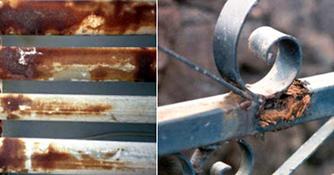Are you curious to know what is wet corrosion? You have come to the right place as I am going to tell you everything about wet corrosion in a very simple explanation. Without further discussion let’s begin to know what is wet corrosion?
Corrosion is a natural process that affects various materials, particularly metals, and can lead to degradation and loss of structural integrity. Among the different types of corrosion, wet corrosion is one of the most common and significant. Wet corrosion occurs when metal is exposed to a corrosive environment, such as moisture or aqueous solutions. In this blog post, we will explore the concept of wet corrosion, its effects on materials, and the preventive measures employed to mitigate its impact.
What Is Wet Corrosion?
Wet corrosion, also known as aqueous corrosion or uniform corrosion, refers to the chemical reaction between a metal and its environment in the presence of a liquid, typically water or a solution containing moisture. This process involves the electrochemical oxidation of the metal, leading to its gradual deterioration over time.
Effects Of Wet Corrosion:
- Metal Degradation: Wet corrosion can result in the gradual deterioration of metal surfaces. The metal reacts with water or moisture to form metal oxides or hydroxides, which weaken the material’s structure and integrity. This degradation can lead to reduced load-bearing capacity, structural failure, and safety hazards in various applications.
- Surface Discoloration and Pitting: Wet corrosion often manifests as surface discoloration, commonly seen as rust on iron and steel. Additionally, localized corrosion in the form of pits or cavities may occur, resulting in localized material loss and weakened areas that are prone to further degradation.
- Financial Loss and Maintenance Costs: The impact of wet corrosion extends beyond material degradation. It can lead to significant financial losses due to the need for repair or replacement of corroded components. Maintenance costs escalate as structures or equipment require regular inspections, surface treatments, and protective coatings to prevent or mitigate corrosion damage.
Prevention And Mitigation Strategies:
- Protective Coatings: Applying protective coatings, such as paints, varnishes, or specialized corrosion-resistant coatings, creates a barrier between the metal surface and the corrosive environment. These coatings act as a sacrificial layer, shielding the metal and hindering direct contact with moisture or aggressive substances.
- Cathodic Protection: Cathodic protection involves the use of sacrificial anodes or impressed current systems to redirect the corrosion process. By introducing a more easily corroded metal, such as zinc or magnesium, the sacrificial anode corrodes instead of the protected metal, effectively protecting it from wet corrosion.
- Corrosion Inhibitors: Chemical inhibitors can be added to the environment or applied directly to the metal surface to inhibit the corrosion process. These inhibitors work by forming a protective film on the metal surface, reducing the electrochemical reactions that cause corrosion.
- Environmental Control: Limiting exposure to moisture or corrosive solutions is an effective preventive measure. Proper ventilation, moisture control, and the use of appropriate drainage systems help minimize the accumulation of moisture and corrosive agents in the vicinity of susceptible metals.
- Material Selection: Choosing corrosion-resistant materials for specific applications is crucial in preventing wet corrosion. Stainless steel, aluminum, and other alloys with high corrosion resistance can be selected to minimize the risk of corrosion in environments prone to moisture or chemical exposure.
Conclusion:
Wet corrosion poses a significant threat to the integrity and longevity of metallic materials in various industries and applications. Understanding the nature of wet corrosion, its effects, and the preventive strategies available is essential to mitigate its impact. By implementing protective coatings, utilizing cathodic protection, employing corrosion inhibitors, controlling the environment, and selecting corrosion-resistant materials, individuals and industries can safeguard against wet corrosion, extend the lifespan of materials, and minimize financial losses associated with corrosion-related damage. Embracing effective corrosion prevention measures ensures the durability, reliability, and safety of structures, equipment, and infrastructure in the face of this pervasive phenomenon.
Empower Your Knowledge By Visiting Techyxl
FAQ
What Is Wet Corrosion Also Called?
Explanation: Wet corrosion is also called as the electro chemical corrosion. Corrosion due to the conducting liquid in contact with cathodic and anodic areas is called as wet corrosion.
What Is An Example Of Wet Corrosion?
Wet corrosion occurs when a metal reacts directly with oxygen in the presence of water. Eg: Corrosion of iron in water to form rust. The corrosion of iron is commonly known as rusting. Iron metal is oxidised to form iron ions.
What Are The Two Types Of Wet Corrosion?
Examples of wet corrosion forms are: Crevice corrosion. Erosion corrosion. Galvanic corrosion.
What Are The Conditions For Wet Corrosion?
Corrosion is the phenomenon of attacking the surface of a metal by air and moisture, so the metal gets corrodes. Necessary conditions for corrosion are: Presence of oxygen and air. Presence of water and moisture.
What Is The Difference Between Dry Corrosion And Wet Corrosion In Tabular Form?
Dry corrosion takes place when there is direct attack of chemical substance in the absence of the moisture . Wet corrosion takes place when there is electrochemical attack occurs in the presence of the moisture or an conducting medium.
I Have Covered All The Following Queries And Topics In The Above Article
What Is Dry Corrosion And Wet Corrosion
What Is Dry And Wet Corrosion
What Is The Effect Of Temperature On The Rate Of Wet Corrosion
Types Of Wet Corrosion
What Is Wet Corrosion Pdf
What Is Wet Corrosion In Chemistry
Wet Corrosion Mechanism
Dry Corrosion Mechanism
Example Of Dry Corrosion And Wet Corrosion
What Is Dry Corrosion
What Is Wet Corrosion
What is wet corrosion with example
What is wet corrosion example?

